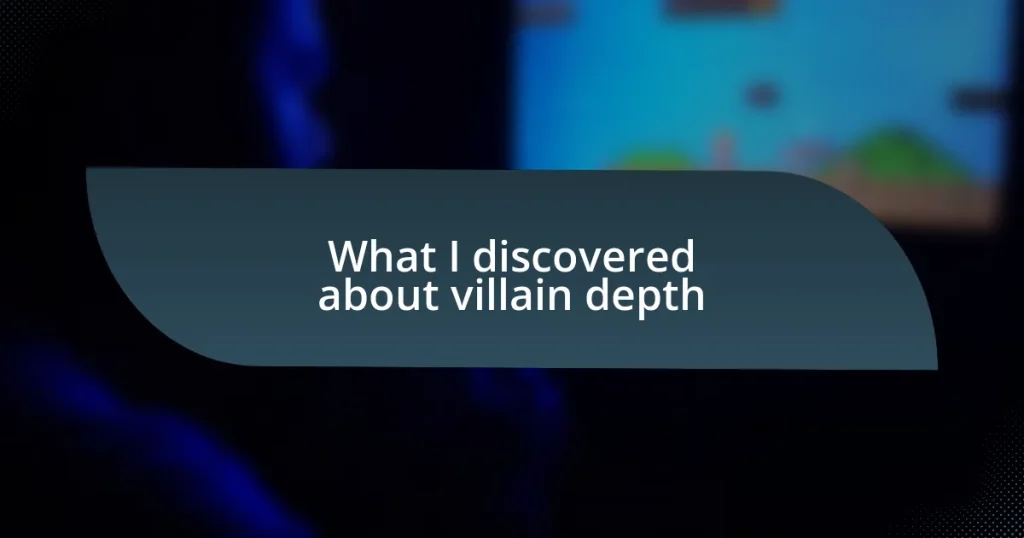Key takeaways:
- Villain depth involves understanding their motivations, often reflecting personal struggles and societal issues, making them relatable.
- Complex villains challenge the binary notion of good versus evil, prompting audiences to explore moral ambiguities and their own vulnerabilities.
- Memorable villains possess strong backstories, unique traits, and psychological connections to protagonists, enhancing engagement and resonance in storytelling.
- Analyzing famous villains like Darth Vader and the Joker reveals the internal conflicts and societal reflections that make their journeys compelling and relatable.
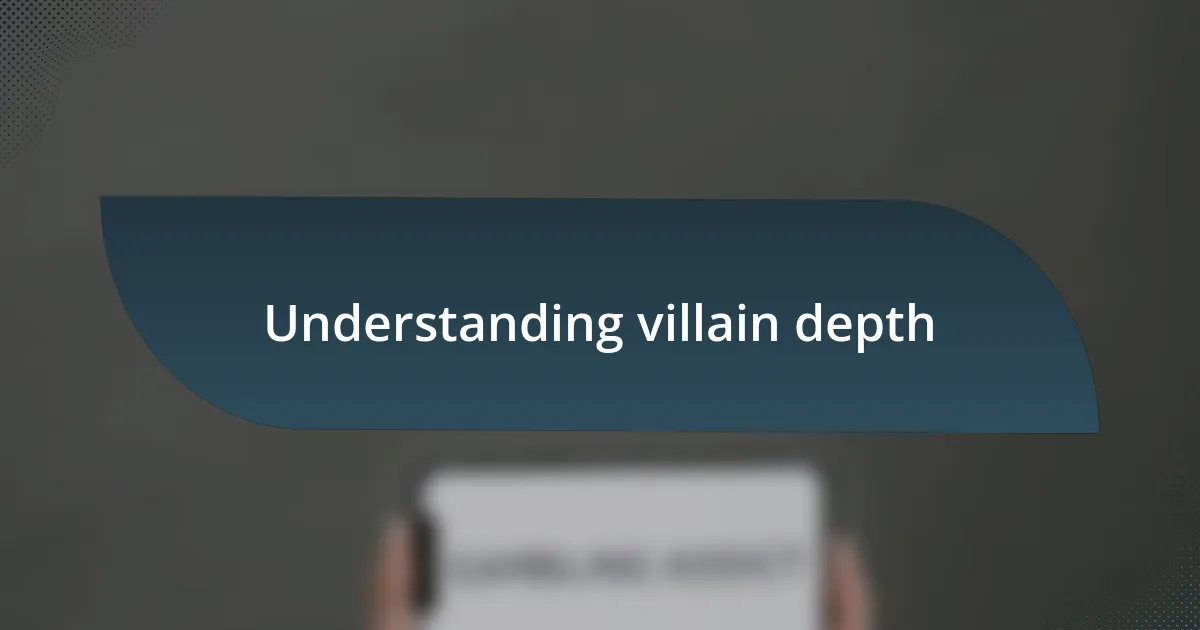
Understanding villain depth
Villain depth goes beyond mere malice; it’s about understanding the motivations that drive these characters. I remember reading a novel where the antagonist’s tragic backstory unfolded, revealing layers of pain and betrayal. It made me question, how often do we define someone solely by their worst actions without exploring the circumstances that shaped them?
In my experience with storytelling, a well-rounded villain often reflects societal issues or personal struggles, making them relatable. For instance, I once created a character whose actions were driven by an unquenchable thirst for acceptance and love. It led me to ponder: isn’t it fascinating how a villain’s journey can mirror our own fears and insecurities, prompting us to reflect on our moral complexities?
When villains display vulnerability, they resonate with us on a deeper level. I’ve found that audiences connect more with characters who have flaws, as it reminds us that everyone is a product of their environment. This realization invites me to ask, how do we balance empathy and accountability in understanding the actions of those we label as “evil”?
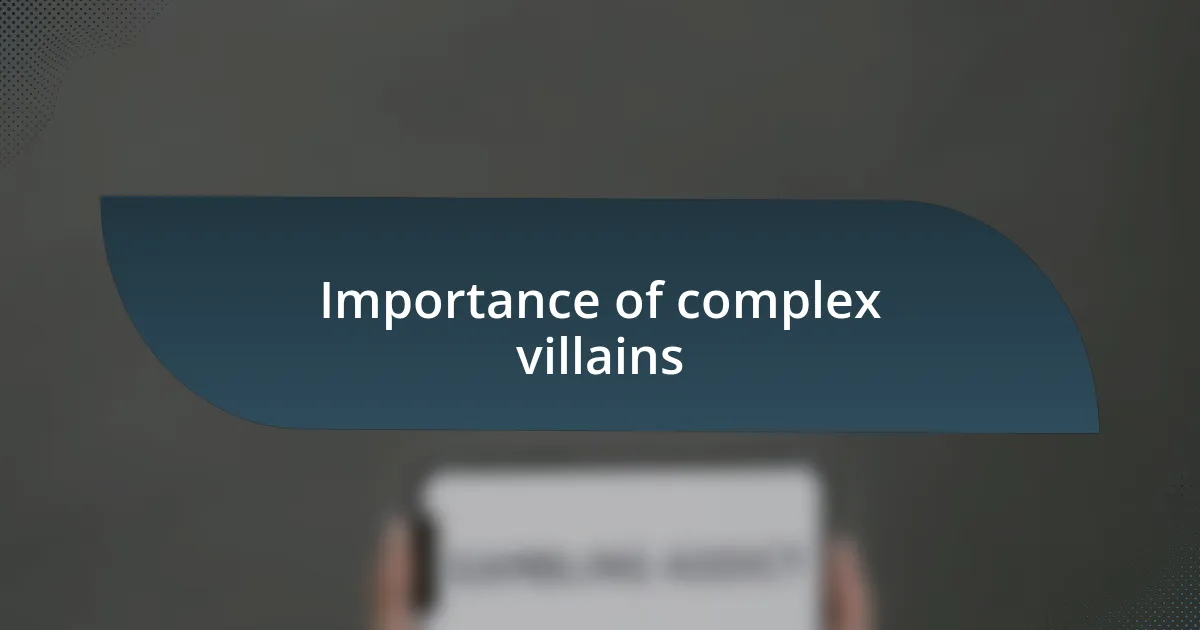
Importance of complex villains
Complex villains play a crucial role in storytelling because they challenge the simplistic notion of good versus evil. I recall a film where the villain, though menacing, was driven by a desire to protect their family despite their violent methods. This made me realize that when villains have relatable motivations, it invites the audience to grapple with their moral compass and consider the complexity of human nature.
Furthermore, the depth of a villain can elevate the stakes within a story, providing tension that keeps the audience engaged. I once crafted a storyline where the antagonist was a former hero who succumbed to despair after losing everything. It wasn’t just their actions that intrigued the audience; it was the tragic arc that made their downfall both compelling and heart-wrenching. Isn’t it remarkable how a complex villain can force us to confront our own vulnerabilities?
On another level, a well-developed villain often serves as a mirror, reflecting society’s flaws and fears back at us. I find that when readers can see the darker aspects of themselves in a villain, it fosters understanding and discussion about real-world issues. For example, in a recent writing exercise, I created a villain whose antagonistic behavior stemmed from societal rejection, sparking conversations about empathy and societal responsibility. This layer of depth invites the audience to rethink their views on morality and existence.
| Simple Villains | Complex Villains |
|---|---|
| One-dimensional motives | Relatable motivations and backgrounds |
| Clear-cut evil | Moral ambiguity |
| Lack of emotional depth | Engagement through vulnerability |
| No societal reflection | Personal and societal issues explored |
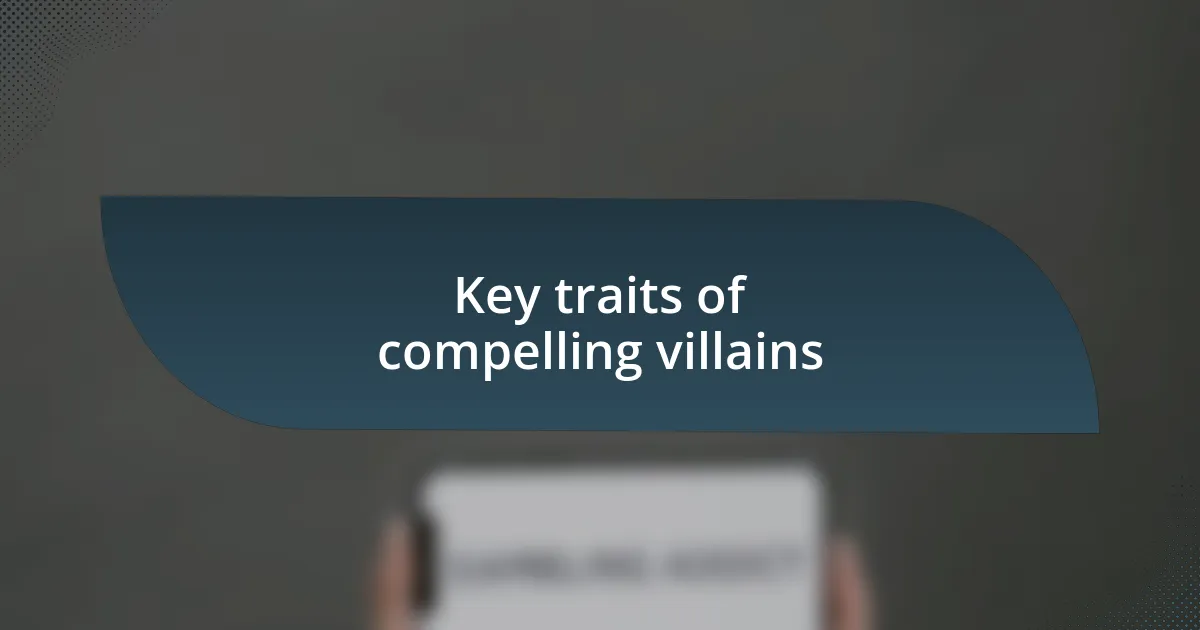
Key traits of compelling villains
Compelling villains often share a set of key traits that elevate their narratives beyond mere entertainment. From my perspective, an intriguing villain should possess a clear motivation that resonates with the audience, echoing their struggles or fears. For instance, I once encountered a character who wielded power ruthlessly; yet, their relentless pursuit stemmed from a deep-seated insecurity that mirrored my own past battles with self-doubt. It’s fascinating how these layers can strike a chord, making the villain not just a foe, but a reflection of our personal struggles.
Here are some key traits of compelling villains:
- Relatable Motivations: Villains who possess understandable goals invite deeper connections with the audience.
- Moral Ambiguity: They push the boundaries of right and wrong, prompting reflection on ethical dilemmas.
- Emotional Vulnerability: Displaying insecurities or past traumas makes them multi-dimensional.
- Intellectual Challenges: A clever villain can outsmart heroes, keeping the audience on the edge of their seats.
- Complex Relationships: Their interactions with other characters often reveal inner conflicts and societal issues.
In my experiences, I’ve found that the best villains don’t merely exist to oppose the hero; they embody the complexities of human nature that we all grapple with. This engagement makes the story richer, allowing us to see a piece of ourselves in them.
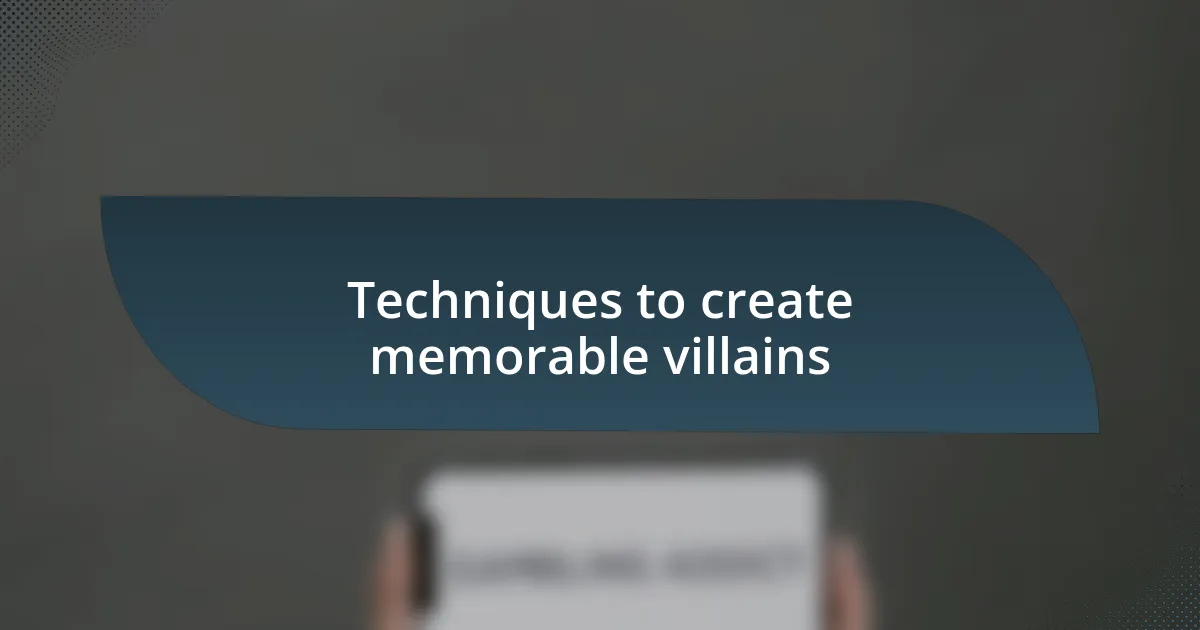
Techniques to create memorable villains
Creating memorable villains often hinges on their backstory. An engaging history adds depth and invites sympathy. I remember encountering a villain in a novel whose tragic past was revealed halfway through the story. Suddenly, I found myself questioning my initial dislike for them. Isn’t it fascinating how a nuanced backstory can transform our perceptions?
Another technique is to establish a strong psychological connection between the villain and the protagonist. This dynamic often leads to riveting confrontations that are rich in conflict and resonance. I once read a book where the hero and villain shared a childhood bond, only to diverge down drastically different paths. This similarity made their encounters fraught with tension and heartbreak, and it made me ponder: How much do our choices really define us?
Lastly, give your villain a unique trait or skill that sets them apart. Whether it’s an unusual obsession or a peculiar way of speaking, these elements can create lasting impressions. I recall a film where the antagonist communicated through riddles, keeping both the protagonist and the audience guessing. It begged the question: How does fear of the unknown shape our understanding of evil? A distinctive character quirk can make a villain unforgettable, adding layers to their story that resonate long after the credits roll.
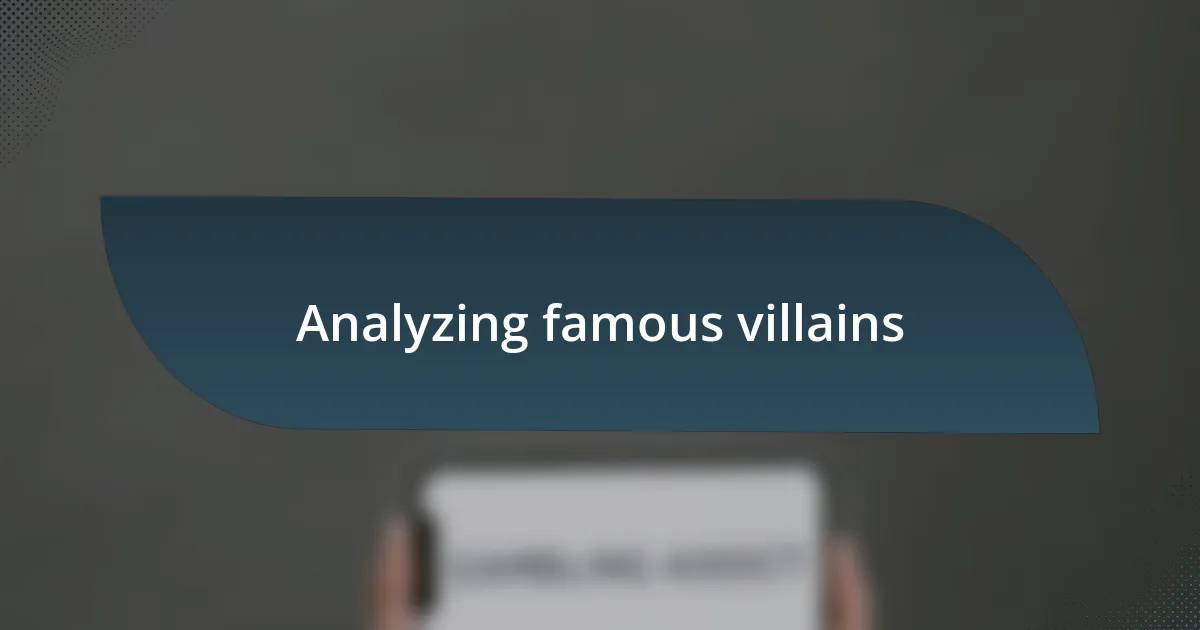
Analyzing famous villains
When analyzing famous villains, I often find their motivations to be deeply fascinating. Take, for instance, the iconic Darth Vader. Initially presented as pure evil, his eventual redemption highlights the internal struggle within him. Reflecting on this, I think about how many people feel torn between their desires and responsibilities in real life. Doesn’t that make Vader’s journey resonate on a personal level?
Another villain that strikes me is the Joker from Christopher Nolan’s “The Dark Knight.” His chaotic nature poses a significant philosophical question: Is he evil for the sake of it, or is he a reflection of societal chaos? I remember watching the film for the first time, and I couldn’t shake the feeling that he was challenging us to confront our own moral boundaries. How often do we overlook the deeper implications behind a character’s madness?
Lastly, I believe the visual representation of villains greatly enhances our perception of them. Consider the unsettling appearance of Gollum from “The Lord of the Rings.” His haunting eyes and ragged demeanor evoke instant empathy, making me recognize that even the darkest characters can spark our compassion. Isn’t it interesting how physical traits can symbolize a villain’s internal struggles, inviting us to explore their complexities further?
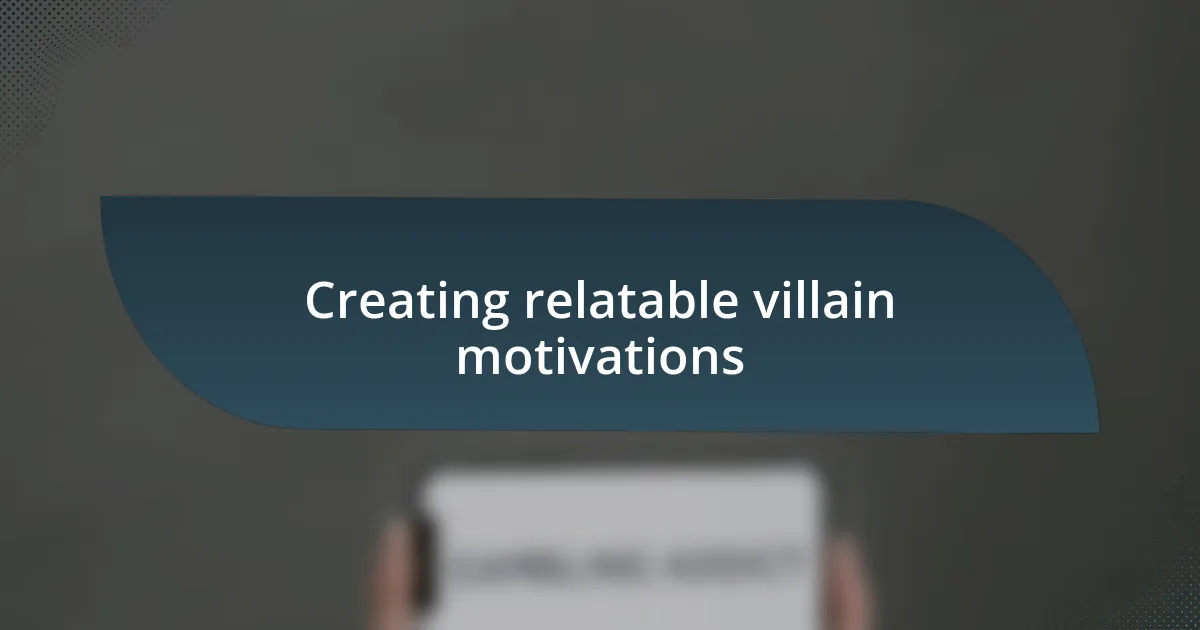
Creating relatable villain motivations
Creating relatable villain motivations often starts with understanding the experiences that shape them. I remember reading about Magneto from the X-Men series, whose tragic backstory of surviving the Holocaust adds profound depth to his character. Encountering such loss and injustice can lead one to feel justified in their quest for revenge. Can we really blame someone for wanting to protect their own kind after experiencing such horror? This understanding allows us to see him not just as a villain, but as a product of his traumatic past.
Moreover, I find that a villain’s emotional vulnerabilities can create strong connections with the audience. Imagine the character of Loki from the Marvel Cinematic Universe. His feelings of inadequacy and longing for acceptance often resonate with those of us who have grappled with familial expectations. His complex blend of ambition and desire for love makes me question: how many of us are driven to darkness by our own unmet needs? It’s this complexity that transforms him from a mere antagonist into someone we can empathize with.
Lastly, I believe that displaying a villain’s relatable motivations can enhance their impact, leading the audience to reflect on their own morals. For instance, when I watched Thanos in “Avengers: Infinity War,” I was struck by his misguided belief that he was saving the universe by eliminating half of its population. It got me thinking about how often we justify our actions in pursuit of a greater good, even when those actions appear destructive. This realization reinforces the idea that perfect villains are rarely born; they evolve through experiences and choices that mirror our own struggles and flaws.











